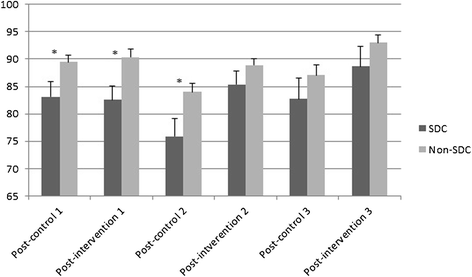Moderate-to-vigorous physically active academic lessons and academic engagement in children with and without a social disadvantage: a within subject experimental design
- PMID: 25927371
- PMCID: PMC4412042
- DOI: 10.1186/s12889-015-1745-y
Moderate-to-vigorous physically active academic lessons and academic engagement in children with and without a social disadvantage: a within subject experimental design
Abstract
Background: Integration of physical active academic lessons in the school curriculum may be an innovative way to improve academic outcomes. This study examined the effect of physically active academic lessons (Fit en Vaardig op school) on academic engagement of socially disadvantaged children and children without this disadvantage. In addition, the relationship between lesson time spent in moderate to vigorous physical activity and academic engagement was examined.
Methods: From four elementary schools, 86 children who participated in the 22-weeks intervention were recruited (23 socially disadvantaged children). Academic engagement was determined by observing time-on-task during three classroom observation moments (start, midway and end observation). Every moment consisted of lesson observations after intervention lessons (post-intervention) and after regular classroom lessons (post-control). Differences in time-on-task between socially disadvantaged children and children without this disadvantage were analyzed using independent samples t-test. Differences between post-intervention and post-control observations were analyzed using multilevel analysis. Heart rate monitors measured the lesson time spent in moderate to vigorous physical activity. The relationship between percentage of moderate to vigorous physical activity during the intervention lessons and time-on-task was analyzed by calculation of partial correlations.
Results: Time-on-task of socially disadvantaged children was lower than that of children without this disadvantage, differences were significant at the start post-control (t(65) = 2.39, p < 0.05) and post-intervention (t(71) = 2.75, p < 0.05) observation and at the midway post-control (t(68) = 2.45, p < 0.05) observation. Multilevel analysis showed that the time-on-task of all children was significantly higher during post-intervention in comparison with post-control lessons (ES = 0.41). No significant difference was found at the start observation, but there were significant differences at the midway (ES = 0.60) and end (ES = 0.59) observation. On average, the children were exercising in moderate to vigorous physical activity during 60% of de lesson time (14 minutes of an average lesson of 23 minutes). No significant relationships were found between percentage of moderate to vigorous physical activity during the intervention and time-on-task in the post-intervention lessons.
Conclusions: Physically active academic lessons may positively influence time-on-task in children, which can contribute to academic success in the long term.
Figures
References
-
- Sirin SR. Socioeconomic status and academic achievement: a meta-analytic review of research. Rev Educ Res. 2005;75:417–453. doi: 10.3102/00346543075003417. - DOI
-
- Greenwood CR, Horton BT. Academic engagement: current perspectives in research and practice. School Psych Rev. 2002;31:328–349.
-
- Wyne MD, Stuck GB. Time-on-task and reading performance in underachieving children. J Reading Behav. 1979;11:119–128.
-
- Scheerens J, Hendriks M, Luyten H, Sleegers P, Glas C. Productive time in education, a review of the effectiveness of teaching time at school, homework and extended time outside school hours. Den Haag: NWO; 2013.
-
- Howse RB, Lange G, Farran DC, Boyles CD. Motivation and self-regulation as predictors of achievement in economically disadvantaged young children. J Exp Educ. 2003;71:151–174. doi: 10.1080/00220970309602061. - DOI
Publication types
MeSH terms
LinkOut - more resources
Full Text Sources
Other Literature Sources
Medical
Research Materials
Miscellaneous


